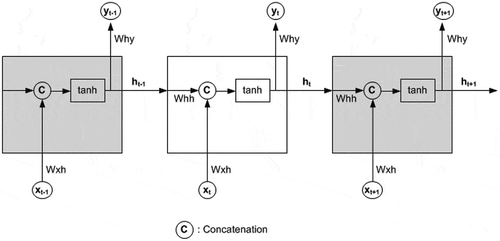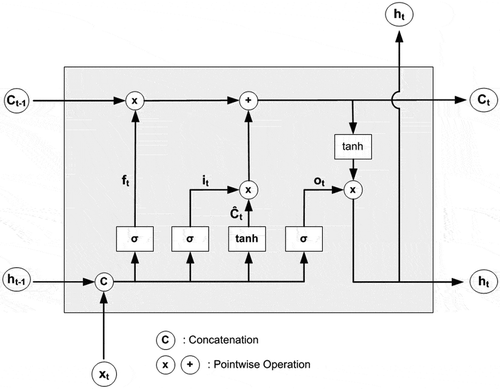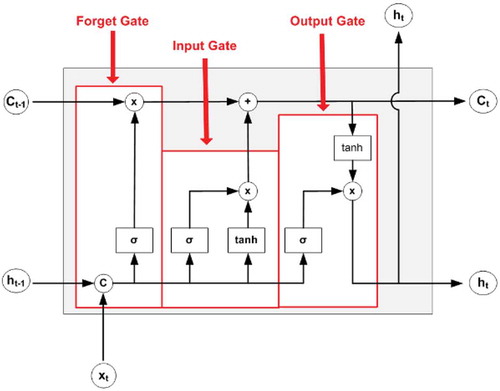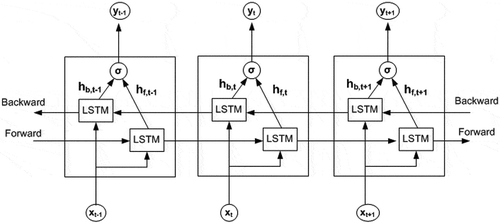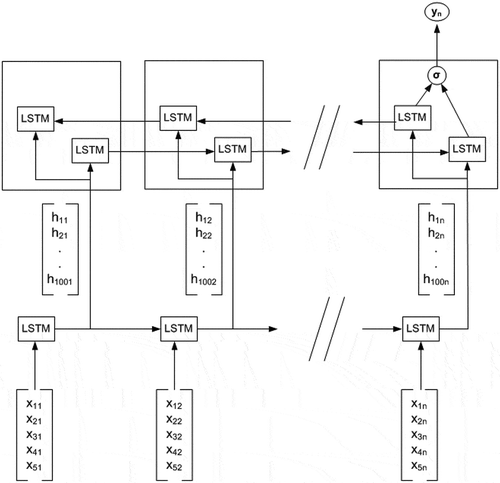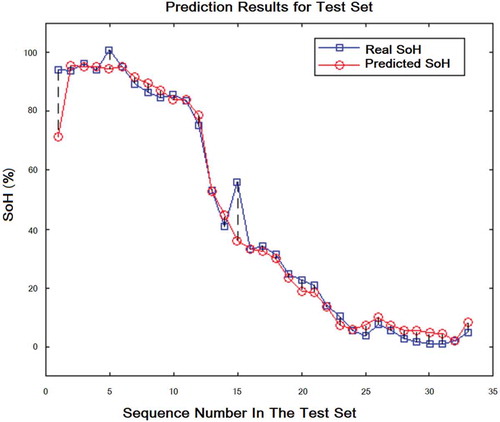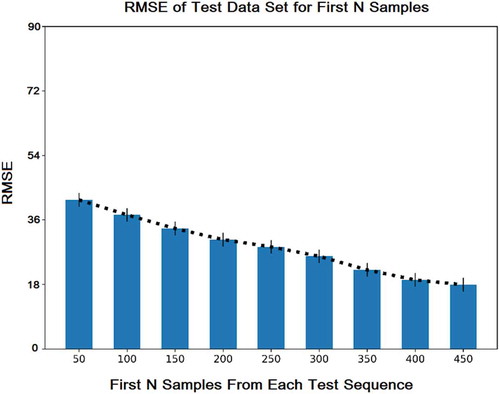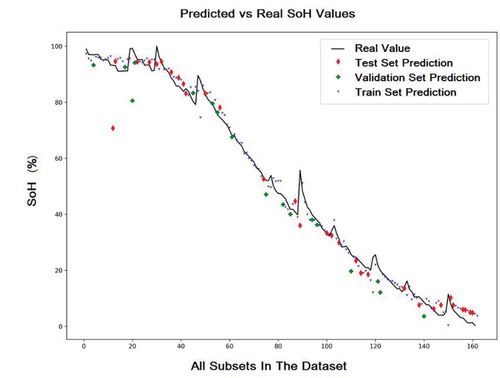 ?Mathematical formulae have been encoded as MathML and are displayed in this HTML version using MathJax in order to improve their display. Uncheck the box to turn MathJax off. This feature requires Javascript. Click on a formula to zoom.
?Mathematical formulae have been encoded as MathML and are displayed in this HTML version using MathJax in order to improve their display. Uncheck the box to turn MathJax off. This feature requires Javascript. Click on a formula to zoom.ABSTRACT
The transition to non-fossil fuels brings with its basic challenges in battery technologies. Due to their efficiency, one of the areas where Li-ion batteries are widely used is electric vehicles (EVs). Range estimation is one of the most important needs in a battery-powered electric vehicle (BEV). The range of BEVs directly depends on battery capacity and powertrain efficiency. Although the electrical performance of Li-ion batteries has significantly improved, it is still not possible to overcome their capacity degradation with aging. State of charge (SoC) and state of health (SoH) are two important measures for a battery. With accurate SoC and SoH estimates, a battery management system can prevent each cell in the battery pack from over-charging or over-discharging, and prolongs the life of the entire pack. The novel idea in this study is to estimate SoH with the data collected during the battery charging process. The most needed moment for SoH is the end of the charging process. With this information, the user can plan the job that the battery will be used with. In order to meet this need, a specially designed deep neural network (stacked LSTM) is trained and tested using measurements only from constant current charging phase of quick charge process. The test results show that this method is effectively applicable to quick chargers.
Introduction
Technological enhancements in the last decade have brought electrical vehicles (EVs) in our lives. EVs have brought many advantages for daily use and the environment compared to petrol cars (Energy sage Citation2020). Also, vision of electrified transportation has been adopted by many smart cities' plans (European Comission Citation2011; Galford Citation2020; Jakobsen Citation2014; Smart Dubai Office Citation2020; Smart Dublin Citation2020). As a result of these, EV market is expanding. For example, in 2019, 540,000 EVs were sold. Global production of EVs is expected to be 4 million in 2020. Also, in 2025, it is expected that the production of EVs will be 12 million annually (Kobie Citation2020). However, LG Chem reported that they could not keep up with the demand for electrical batteries. Also, Mercedes-Benz has revisited EV goals for sales (The Verge Citation2020). It is known that the battery is the heart of EVs. Automobile engines cannot start without a proper electric supply (Roy et al. Citation2015). These issues have created concerns about the efficiency and health of batteries. Simlett and Mortier mentioned that managing battery life cycle will play a key role in future EVs (O’kane Citation2020). Therefore, the health of battery or state of health (SoH) is an important topic in today and near future.
A study done by Zhao et al. (Citation2017) proposes a battery remaining useful life prediction (RUL) method based on deep belief network (DBN) and relevance vector machine (RVM). Features extracted by DBN provide input for Non-volatile memory (NVM). The proposed method gives acceptable Li-ion RUL prediction but prediction accuracy needs to be improved. A study done by Dong et al. (Citation2014) proposes support vector regression-particle filter (SVR-PF) on battery SoH monitoring and RUL prediction. With experiments, it is found that when the number of charge and discharge cycles increases, battery capacity decreases and battery impedance increases. These parameters are used for RUL estimation of battery with implemented SVR-PF algorithm. Although it is said that the SVR-PF algorithm has robust performance, RUL estimation threshold and end of life (EOL) threshold limit predictions in a narrow band (between 85% and 70% of nominal capacity). Thus, this method is not applicable for most of the cases. In Liu et al. (Citation2013), battery SoH estimation approach has been presented on data-driven Gaussian process regression (GPR) algorithms. To improve the poor performance of the GPR algorithm, Gaussian process functional regression (GPFR) algorithm has been utilized. GPFR and GPR models are trained with a number of charge/discharge cycles and available capacity at that cycle. Then, training hyper-parameters are optimized and tested. Lastly, predictions are converted to battery SoH estimation with a mathematical equation. Even though the proposed method can predict a wider nominal capacity range, Li-ion battery degradation can vary in different conditions and can increase the error significantly. Another GPR-based SoH estimation method was proposed by Yang et al. (Citation2017). The proposed method uses charging curve to estimate SoH of Li-ion batteries. In this study, four features are explained and extracted from charging curves. Firstly, in constant current mode, while cycle number increases the constant current time decreases. Secondly, constant voltage mode duration increases while cycle number increases. Thirdly, constant charging slope increases while cycle number increases. Finally, vertical slope at the corner of constant current increases while cycle number increases. Features are extracted through these curves and formed as input data set. GRA method is applied to analyze relational grade. Results show that, in training phase, the proposed model predictions are very accurate. But in testing phase, the proposed GPR model prediction error increases significantly. It can be said that the model is not properly optimized or the model is overfitted.
In AI-based SoH predictions, Zhang et al. (Citation2018b) proposed a SoH prediction method with long short-term memory (LSTM), which is a special type of RNN. The proposed method can predict the RUL of Li-ion battery with a low amount of data. Andre et al. (Citation2013) compare two parameter estimation methods (extended Kalman filter and structured neural network) for SoH determination. For SoH determination, the measured values of State of Charge (SoC), temperature, and current. Test results show that compared to extended Kalman filter, structured neural network gives more stable results. In a study (Ren et al. Citation2018), DNN-based RUL prediction model is proposed for multi-battery RUL estimation. The model is tested with Li-ion battery data set. In Li et al. (Citation2019), hybrid Elman-LSTM method is presented for Li-ion battery RUL prediction. According to battery capacity, cycle number, and discharge of battery, RUL of the battery is predicted with the hybrid Elman-LSTM method. A study done by Yang et al. (Citation2017) proposes a simple method estimating battery’s SoH based on three-layer BPNN. Inputs of the NN model are ohmic resistance, polarization resistance, polarization capacity, and SoC. Output of the NN model provides the SoH estimation. The model is tested on LiFePo4 batteries. Bonfitto et al. (Citation2019) presented the SoH estimation of technique-based ANN pattern recognition structure. Voltage, temperature, capacity, energy, and estimated SoC are given to the structure, and when similar patterns occur, the output of the ANN estimates SoH for lithium batteries.
Among further studies, in Tang et al. (Citation2018) fast SoH estimation algorithm was proposed for Li-ion batteries. This method firstly measures the current and voltage trajectories of battery cells at certain times. The obtained measurements fit in dQ/dV curve and proper filtering algorithms are applied. Next, the peak of the filtered curve calculates regional capacity at a specific time and SoH is estimated with regional capacity at a specific time divided by rated capacity taken from the specification sheet at 25°C. Test results give less than 2.5% estimation error. But the proposed approach is not optimal for high current rate, different temperatures, or shallow charge/discharge cycles. Furthermore, Yang et al. (Citation2017) proposed a SoH estimation method for analyzing constant voltage charging current. In the constant voltage charging period, battery voltage and current are recorded. Preliminary analysis and curve fitting of the recorded data set is considered as robust characteristic parameter, which is related to capacity fading. Lastly, battery SoH can be derived using the correlation with obtained parameters. The developed method proposed good results but only for LiFePo4 batteries at constant environment conditions. Ma, Yang, and Wang (Citation2019) proposed a data-model fusion battery SoH estimation approach. The open circuit voltage (OCV) model is presented, and incremental capacity analysis and differential voltage analysis method are combined. The SoH estimation model is developed based on the correlation between variations of OCV model parameters. It is mentioned that work could be improved with temperature dependency.
For both SoC and SoH prediction, in a study Chaoui and Ibe Ekeocha (Citation2017) propose a SoC and SoH estimation technique, which is tested on online electric vehicle LiFePO4 and LTO batteries. Dynamically driven recurrent networks are designed for both SoC and SoH estimation. The given technique uses the battery’s voltage, charge/discharge currents, and ambient temperature variations to estimate SoC and SoH of the battery simultaneously. In an article done by Talha, Asghar, and Kim (Citation2019), they propose ANN-based online SoC and SoH estimation technique for lead-acid batteries. Voltage and current are used in single-layer neural network for SoC and SoH estimation. The proposed simple mathematical calculations give an opportunity to real-time estimation.
By the nature of batteries’ inner structure, battery capacity degrades with every charge–discharge cycle. This battery health capacity decrease has a non-linear character that cannot be modeled with the traditional method (Zhang, Hou, and Zhang Citation2020). In recent years, ANN have become popular in battery SOH prediction with the ability to deal with nonlinearities in systems. In this respect, LSTM, which has been widely adopted in research areas like audio video and text processing, has a high potential in accurate SOH prediction. LSTM is a time-dependent structure and generally used for learning long-term dependencies. Beyond the traditional RNN models, LSTM provides a judge mechanism to judge if the information is useful or not (Yu et al. Citation2019). When data enter the LSTM cell, it is judged with learned rules and mismatched information is forgotten. Moreover, LSTM structure can simplify AI computational tasks and increase network efficiency at cell level (Bak and Lee Citation2019; Chen et al. Citation2018; Zhang et al. Citation2017). Compared to standard RNN methods, the LSTM network can maintain information in memory for long periods of time. This also provides advantage in long- and short-range dependencies (Sherstinsky Citation2020). In battery management systems, battery degradation data that cover hundreds of battery cycles can be the source for accurate LSTM-based estimation. In this case, utilizing LSTM structure in battery health estimation will provide highly accurate results.
In this study, the novel ideas are to estimate the SoH of the battery with the data collected in the period of constant current part of the quick charging process, and secondly the proposed deep neural network that consists of a stacked LSTM-BiLSTM structure. The moment that the SoH information is most needed is the end of the charge process. With this knowledge, a user can plan the work where the battery will be used. In order to do that, a specially designed deep neural network is trained and tested with the data of charging. The remaining of the paper is organized as follows: preliminaries and definitions for technologies and data set used are given in the following section. The proposed method is given in Section 3. Section 4 presents the tests undertaken and a discussion of their findings. Finally, conclusions and future works are given in the last section.
Preliminaries and Definitions
Today, lots of electronic/electromechanical devices run with batteries, therefore battery technology is one of the crucial technologies in this century. Batteries depending on their type have different properties in terms of advantages and disadvantages. However, all of them are affected from health degradation. SoH is a measure of current capacity of the battery with respect to its fabricated capacity and end of life (EOL) capacity. Through the usage, the capacity falls from fabricated capacity to EOL capacity with time. The capacity estimation of a used battery gives valuable information for the planning of maintenance and rest of the work done. The straightforward way of estimation of battery capacity is based on discharge data. In the discharge process, energy accumulated on the battery is drained through a load. The capacity can be calculated by integrating the energy flown out of the battery. Impedance measurement is another way of capacity estimation. For this measurement, special expensive measurement equipment must be used through the charge process. This equipment must be integrated to the inside of the battery. For small batteries and some special types, this method may not be applicable.
There are different charging methods for Li-ion batteries. The two most known are constant voltage and constant current methods. In the constant voltage method, constant voltage is applied to charge the battery. The current drawn by the battery falls and approaches a constant value, therefore the charging rate falls with time. In the constant current method, constant current is fed to the battery. The voltage of the battery rises with time. This method has a high and constant charging rate but it includes the danger of explosion of the battery. The hybrid method, known as quick charge, is the combination of these two methods. Firstly, constant current is applied until the battery voltage rises to a specified voltage. Secondly, constant voltage is applied until the current falls to a specified value. At the end, a constant standby voltage is applied to keep the battery charged. Quick charge procedure as shown in is commonly used, especially with Li-Ion batteries, for its time-saving property.
Recurrent neural network is a special model that is suitable for sequential information. In a traditional neural network, it is assumed that all inputs (and outputs) are independent of each other. RNNs have a memory unit to capture past information; therefore, they are called recurrent (Zhang et al. Citation2018a). Thus, they perform well in processing sequences or time series.
shows an RNN unit unfolded for three steps where ht is the hidden state of RNN at time t and Whh, Wxh, Why are the weight matrices used for from h to h, from x to h, and from h to y, respectively.
LSTM is a popular variation of RNN. LSTM has the capability to utilize historical data. LSTM networks have the ability of holding long-term connections within these data. LSTM solves the vanishing gradient problem that RNN suffers from. LSTM is an ideal tool for classification and estimating time series in a way that is independent of the time period.
In , the inside of an LSTM unit is shown with
where Wf, Wi, Wo, and Wc are the weight matrices connecting concatenation of the previous cell output state with hidden layer input to the three gates and the input cell state. The bf, bi, bc, and bo are four bias vectors. The σ is the gate activation function, which normally is a sigmoid function, and the tanh is the hyperbolic tangent function.
An LSTM unit has a forget gate, input gate, and output gate as shown in . The unrolled structure of an LSTM unit is given in .
A bidirectional LSTM (BiLSTM) unit is composed of a pair of LSTM units. In training BiLSTMs, data are fed once from the beginning to end and then from end to the beginning. It usually learns faster than the one-directional approach, although this property depends on the task. The difference between LSTM and BiLSTM is that BiLSTM works in two directions: one moves onward with past data and the other moves backward with future data as shown in . The output of the BiLSTM hidden unit is given in EEquationquation (9)(9)
(9) .
Data set used (Saha and Goebel Citation2007) in this study is from the NASA repository. Battery no: B0005 data from Battery Data Set 1 is used. In this data set, a Li-ion battery was run through three different operational profiles (charge, discharge, and impedance) at room temperature. Charging was carried out in a constant current (CC) mode at 1.5 A until the battery voltage reached 4.2 V and then continued in a constant voltage (CV) mode until the charge current dropped to 20 mA.
Repeated charge and discharge cycles result in accelerated aging of the batteries. The experiments were stopped when the batteries passed EOL criteria, which was a 30% fade in rated capacity. There are 169 cycles each of which contains charge, discharge, or impedance operations. We use only charge operations data and only rated capacity information from discharge operations. Explanations of data used are given below:
Voltage measured: battery terminal voltage (V)
Current measured: battery output current (A)
Temperature measured: battery temperature (°C)
Current charge: current measured at charger (A)
Voltage charge: voltage measured at charger (V)
Time: time vector for the cycle (s)
Capacity: battery capacity (Ah) for discharge till 2.7 V
In this study, Dell Precision Tower with 3.80 GHz Intel Xeon CPU E3-1270 v6 CPU, 16 GB ECC RAM, 5 GB NVIDIA Quadro P2000 is used as the hardware platform. Besides, Python libraries like PyTorch, NumPy, SciPy, and Matplotlib are used for designing and testing the proposed stacked LSTM deep neural network.
Proposed Method
In this study, the novel idea is to estimate the SoH of the battery with the data collected during the charging process. The moment that the SoH information is most needed is the end of a charging process. With this knowledge, a user can plan the work where the battery will be used. In order to do that, a specially designed deep neural network is trained and tested with the data, which are measured during charging.
For the data needed, we use NASA battery database. In the database, there are 169 charge–discharge cycles. At the end of each discharge, the calculated capacity of the battery is also given. This capacity must be fueled at the previous charging. This means that, at the end of each charging process, the capacity of the battery is known. The battery B0005 used has the max capacity of 1.8518 Ah in the data set. Considering this value, 30% faded capacity is 1.2979 Ah, which was accepted as EOL capacity. Seven cycles that are under this capacity were excluded and 162 charge–discharge cycles were used in this study
For each charging process, there are five measurements with time stamp. These are;
Voltage measured
Current measured
Temperature measured
Current charge
Voltage charge
Each charging process is a quick charge so it contains three parts: CC, CV, and standby. Standby part is not relevant to charging; therefore, it is removed. Removing the standby part is done automatically by a script that observes the charger current to fall to a specified value. The CC part is the main charging section since generally in less than 25% charging time more than 60% of the capacity is charged here. Therefore, in this study data that only belong to the CC part is used.
The number of time samples (length of the sequence) in each charge process is different. The charge cycles are divided randomly as 70% for training, 20% for testing, and 10% for validation. Therefore, we have 114 cycles for train, 31 cycles for test, and 17 cycles for validation.
Since the length of the sequence is varying, a neural network structure which is independent from the length of the sequence is needed. The designed network structure has four layers. The five measurements of the CC charging are formed as a feature vector input shown in as X. Due to the time-series performance of LSTM and BiLSTM, they are used in a cascaded form. In the data set, the average length of sequences is 812, with a standard deviation of 237. In order to capture different patterns and correlations, the number of hidden units of LSTM and BiLSTM layers is selected as 100. The LSTM layer is set to sequence output so each hidden unit of this layer has an output for every input. BiLSTM layer is set to the last output. It means that each hidden unit of this layer produces only one output after all inputs are completed. The last layer is a fully connected layer that combines all outputs from hidden units of BiLSTM layer into a single value, which is the SoH of the battery.
Training of deep learning models has its own difficulties. Adam optimizer (adaptive moment estimation) is a well-established optimization algorithm based on the RMSProp method, which stems from the stochastic gradient descent method. In our experiments, PyTorch library’s implementation of Adam optimizer is utilized. The optimization algorithm is run at every updating step after taking a batch size of samples from the training set. The new weights are calculated by the optimization algorithm according to the gradients. Some of the problems encountered in the training step are gradients exploding and diminishing, oscillations of training, and instability of the overall process. Adam optimizer has been observed to overcome these issues (Kingma and Ba Citation2014). Therefore, Adam optimizer is selected for these benefits. Besides, considering the average length of sequences, the minibatch size is selected as 10.
Test and Results
The total number of all charging sequences used is 162. The data set is randomly divided into three subsets: training (70%), validation (10%), and testing (20%). During the experiments, the mean training durations were measured as 25 minutes, while testing a single sample (inference) takes place under 5 seconds. The statistical information about the sequences belonging to each one of the subsets is given in .
Table 1. Statistical information about the sequences that were randomly selected for each one of the three subsets
The training process was conducted for 50 epochs by utilizing a learning rate scheduling. The initial learning rate of 0.01 was dropped with a factor of 0.2 after seven epochs. In order to quantitatively assess the performance of the proposed approach, root mean square error (RMSE) for both training and test data sets is calculated as
where ŷ_iy ̂i is the estimated SoH value of the ith sequence inferred from the network output given the sequence as an input, and y_i is the corresponding ground-truth value taken from the following discharge cycle. N denotes the total number of sequences within the data set. According to this, SoH RMSE values are given in for the training and test data sets.
Table 2. Root mean square errors for the training and test data sets after the network is trained
In , the predicted and real SoH values and the prediction error for each sequence in the test data set are shown.
In order to investigate any potential overfitting issues, the log loss value after each epoch for both the training and the validation data sets is plotted in . As the validation line follows the training line, it can be asserted that no overfitting occurred during the training process.
While a test is conducted for any given sequence by predicting the output from the whole length of the sequence, one might wonder the effect of taking the first N number of data of a sequence. Such an investigation for the test data set was carried out, and the average RMSE results are plotted against the number of sequences taken as input in . As the N increases, the average error rate decreases. This is an expected behavior since more information about a charging process is being fed into the trained network.
In , the SoH values for each cycle in all of the three subsets are plotted together. As seen in the figure, real values have also irregulates, which creates difficulties in training.
In another representation, prediction results can be plotted as cycle number versus capacity estimation, as shown in . In this representation, real capacity values in Ampere-hours rather than SoH percentage in all subsets show that the training process is successful and no overfitting issues have occurred. Secondly, prediction of samples in test and validation subsets is satisfactory except only two outlier points located in the early beginnings of charge and discharge cycles.
In , the studies with Li-ion batteries similar to our study referred to in Section 1 are listed. In the proposed method, SoH RMSE for the test set is found as 5.501, which indicates a good performance among the listed studies.
Table 3. Literature results summary for battery SoH prediction
Conclusion and Future Works
In this study, a novel method for predicting SoH of Li-ion batteries based on stacked BiLSTM deep neural network and usage of only constant current charging data are proposed. The constant current part of the quick charge is the first and the most used section in charging Li-ion batteries. This method gives the SoH value of the battery by utilizing only measurements of constant current charging parameters, i.e. charging current, charging voltage, measured current, measured voltage, and measured temperature. It means that after constant current charging begins this method can predict the SoH and the prediction error will decrease down to 5.5% (RMSE) with more data is measured and included. The RMSE of capacity in terms of Ampere-hours is found as 0.033. Therefore, it can be used in charging operations in order to predict SoH very effectively within an acceptable error rate with any quick charger for Li-ion batteries after training the proposed deep neural network model.
The proposed stacked BiLSTM model structure is found to be successful in predicting SoH of batteries because of its bidirectional nature, where the training process includes combining onward and backward data of the measurements, therefore enabling a more robust training phase, after which any new sample’s output is predicted more reliably than other recurrent networks or unidirectional LSTM models.
Our future works include working on any other Li-ion data sets available in order to prove the effectiveness of the proposed model and optimizing it. Augmentation of the method to decrease the prediction error, especially for restricted input data, which is the case for short charging times, is also another important work ahead.
References
- 2011 – Hamburg. Accessed February 24 2020.
- Advantages of electric cars – Top benefits of EVs. energy sage, Smarter energy decisions. Accessed February 24, 2020. https://www.energysage.com/electric-vehicles/advantages-of-evs/.
- Andre, D., A. Nuhic, T. Soczka-Guth, and D. U. Sauer. 2013. Comparative study of a structured neural network and an extended Kalman filter for state of health determination of lithium-ion batteries in hybrid electric vehicles. Engineering Applications of Artificial Intelligence 26 (3):951–61. doi:10.1016/j.engappai.2012.09.013.
- Bak, T., and S. Lee. 2019. Accurate estimation of battery SOH and RUL based on a progressive LSTM with a time compensated entropy index. Annual Conference of the PHM Society, 11 (1).
- Bonfitto, A., E. Ezemobi, N. Amati, S. Feraco, A. Tonoli, and S. Hegde. 2019. State of health estimation of lithium batteries for automotive applications with artificial neural networks. 2019 AEIT International Conference of Electrical and Electronic Technologies for Automotive (AEIT AUTOMOTIVE), Politecnico di Torino, Lingott21-25o. doi:10.23919/eeta.2019.8804567
- Chaoui, H., and C. C. Ibe Ekeocha. 2017. State of charge and state of health estimation for lithium batteries using recurrent neural networks. IEEE Transactions on Vehicular Technology 66 (10):8773–83. doi:10.1109/tvt.2017.2715333.
- Chen, Z., X. Song, R. Xiao, J. Shen, and X. Xia. 2018. State of health estimation for lithium-ion battery based on long short term memory networks. DEStech transactions on environment. Energy and Earth Sciences, (ICEEE)Swinburne Univ Technol, Melbourne, Australia, 21–25.
- Dong, H., X. Jin, Y. Lou, and C. Wang. 2014. Lithium-ion battery state of health monitoring and remaining useful life prediction based on support vector regression-particle filter. Journal of Power Sources 271:114–23. doi:10.1016/j.jpowsour.2014.07.176.
- European Commission, Hamburg – European Green Capital 2011, https://ec.europa.eu/environment/europeangreencapital/wp-content/uploads/2011/04/Doku-Umwelthauptstadt-engl-web.pdf, Accessed, March15, 2021
- Galford, C., “AEP Ohio to build car charging stations as part of columbus Smart City initiative”. Daily Energy Insider. Accessed February 24 2020.
- Jakobsen, K. H. 2014. Connecting copenhagen’ is the world’s best Smart City project. State of Green. Accessed February 24, 2020. https://stateofgreen.com/en/partners/city-of-copenhagen/news/connecting-copenhagen-is-the-worlds-best-smart-city-project/.
- Kingma, D. P., and J. Ba. 2014. Adam: A method for stochastic optimization. arXiv Preprint arXiv:1412.6980.
- Kobie. 2020. As electric car sales soar, the industry faces a cobalt crisis. Wired, Condé Nast Britain . Accessed February 24, 2020. https://www.wired.co.uk/article/cobalt-battery-evs-shortage.
- Li, X., L. Zhang, Z. Wang, and P. Dong. 2019. Remaining useful life prediction for lithium-ion batteries based on a hybrid model combining the long short-term memory and Elman neural networks. Journal of Energy Storage 21:510–18. doi:10.1016/j.est.2018.12.011.
- Liu, D., J. Pang, J. Zhou, Y. Peng, and M. Pecht. 2013. Prognostics for state of health estimation of lithium-ion batteries based on combination Gaussian process functional regression. Microelectronics Reliability 53 (6):832–39. doi:10.1016/j.microrel.2013.03.010.
- Ma, Z., R. Yang, and Z. Wang. 2019. A novel data-model fusion state-of-health estimation approach for lithium-ion batteries. Applied Energy 237:836–47. doi:10.1016/j.apenergy.2018.12.071.
- O’kane, S. 2020. Jaguar will pause I-pace production because of battery shortage. The Verge, Vox Media. Accessed February 24, 2020.https://www.ey.com/en_lu/automotive-transportation/why-the-ev-battery-life-cycle-is-more-important-than-the-battery-life.
- Ren, L., L. Zhao, S. Hong, S. Zhao, H. Wang, and L. Zhang. 2018. Remaining useful life prediction for lithium-ion battery: A deep learning approach. IEEE Access 6:50587–98. doi:10.1109/ACCESS.2018.2858856.
- Roy, P., M. Md., S. Akther, and M. Kader. (2015). Importance and proper way of maintaining a battery.
- Saha, B., and K. Goebel (2007). Battery data set. NASA AMES prognostics data repository.
- Sherstinsky, A. 2020. Fundamentals of recurrent neural network (rnn) and long short-term memory (lstm) network. Physica D. Nonlinear Phenomena 404:132306. doi:10.1016/j.physd.2019.132306.
- Smart Dubai. 2021. Smart Dubai, smart Dubai office. Accessed February 24, 2020. https://2021.smartdubai.ae/.
- Smart Dublin, Smart Dublin. 2020. Accessed February 24, 2020. https://smartdublin.ie/.
- Talha, M., F. Asghar, and S. H. Kim. 2019. A neural network-based robust online SOC and SOH estimation for sealed lead–acid batteries in renewable systems. Arabian Journal for Science and Engineering 44 (3):1869–81. doi:10.1007/s13369-018-3200-8.
- Tang, X., C. Zou, K. Yao, G. Chen, B. Liu, Z. He, and F. Gao. 2018. A fast estimation algorithm for lithium-ion battery state of health. Journal of Power Sources 396:453–58. doi:10.1016/j.jpowsour.2018.06.036.
- Yang, D., X. Zhang, R. Pan, Y. Wang, and Z. Chen. 2018a. A novel Gaussian process regression model for state-of-health estimation of lithium-ion battery using charging curve. Journal of Power Sources 384:387–95. doi:10.1016/j.jpowsour.2018.03.015.
- Yang, D., Y. Wang, R. Pan, R. Chen, and Z. Chen. 2017. A neural network based state-of-health estimation of lithium-ion battery in electric vehicles. Energy Procedia 105:2059–64. doi:10.1016/j.egypro.2017.03.583.
- Yu, Y., X. Si, C. Hu, and J. Zhang. 2019. A review of recurrent neural networks: LSTM cells and network architectures. Neural Computation 31 (7):1235–70. doi:10.1162/neco_a_01199.
- Zhang, J., J. Hou, and Z. Zhang. 2020. Online state-of-health estimation for the lithium-ion battery based on an LSTM neural network with attention mechanism. In 2020 Chinese Control And Decision Conference (CCDC). Empark Grand Hotel Anhui, Hefei, China: IEEE, August, 1334–39.
- Zhang, Q., L. T. Yang, Z. Chen, and P. Li. 2018a. A survey on deep learning for big data. Information Fusion 42:146–57. doi:10.1016/j.inffus.2017.10.006.
- Zhang, Y., R. Xiong, H. He, and M. G. Pecht. 2018b. Long short-term memory recurrent neural network for remaining useful life prediction of lithium-ion batteries. IEEE Transactions on Vehicular Technology 67 (7):5695–705. doi:10.1109/tvt.2018.2805189.
- Zhang, Y., R. Xiong, H. He, and Z. Liu. 2017. A LSTM-RNN method for the lithuim-ion battery remaining useful life prediction. 2017 Prognostics and System Health Management Conference (PHM-Harbin), Harbin, China. doi:10.1109/phm.2017.8079316
- Zhao, G., G. Zhang, Y. Liu, B. Zhang, and C. Hu (2017). Lithium-ion battery remaining useful life prediction with deep belief network and relevance vector machine. 2017 IEEE International Conference on Prognostics and Health Management (ICPHM), Dallas, TX, USA. doi:10.1109/icphm.2017.7998298


